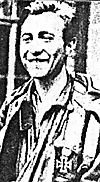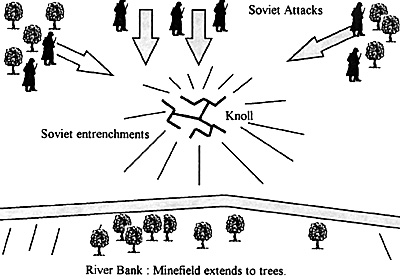Just a few short hours after Operation Barbarossa began on June 22, 1941, Francoist Spain offered her services to the Reich in the form of a division of volunteers to fight in Russia. The prosepect of seeing action against "International Communism", brought forth a surge of popular enthusiam in Spain, and throughout the country potential recruits flocked to Falange party stations and Army barracks to enlist. By July 2nd, over 50,000 Spaniards had volunteered.
The "Azul" or "Blue" Division was created from a mix of regular soldiers and volunteers, many who had been commanded by 45 year old aristocratic General Agustin Munoz Grandes, who during the Civil War had been a succesful Corps commander, and briefly, the Secretary General of the Falangist Party.
The Division arrived at the Grafenwohr training ground in Bavaria on 17 July, 1941. Here the Spanish volunteers were re-organised to follow the German 'triangular' TOE and the Blue Division officially entered the German establishment as the 250.Infanterie-Division of the Heer.
262 Infanterie-Regiment - CO Colonel Pimentel (Barcelona)
263 Infanterie-Regiment
- CO Colonel Vierna (Valencia)
269 Infanterie-Regiment - CO Colonel Esparza
(Seville)
Within the division, the regiments were known by the names of their commanding officers - e.g. "Regimento Pimentel".
Total strength of the Division in August 1941 was: 641 Officers, 2,272 NCO's,and 15,780 soldiers. Each regiment consisted of 3 battalions, of 3 rifle and 1 heavy companies (of mixed mortars & MGs). Companies within a regiment were numbered consequetively, thus the 1st Battalion had 1-4, 2nd Battalion 5-8, 3rd Battalion 9-12. Additionally, each regiment had a bicycle company (no.11), Close Support company of six 75mm I.G.18 guns and two s.I.G.33 150mm howitzers (no.13), anti-tank company of four sections of three PaK38 37mm anti-tank guns (no.14) and a headquaters company with an assault engineer platoon (no.15).
Divisional assets included the 250.Artillerie-Regiment (Colonel Badillo) consisting of three light-gruppos, each of 3 batteries of 105mm (105/28) guns, and a Heavy-gruppo of 150mm (150/30) guns (all horse drawn). The 250.Panzerjager-Abteilung was armed with 36 Pak38`s, but due to the Wehrmacht`s diminishing stocks of motor transport, there were no vehicles available with a cross country ability. Instead civillian touring cars and limousines had been requisitioned from as far away as Southern France - Peugeouts & Packards with leather seats, radios and heaters (an excellent excuse to use that French staff car from Peter Pig). The divisional cavalry was converted to motorcycles. A reserve battalion of three rifle companies was formed - 250 Mobile Reserve - initially they were designed to provide a pool of replacements for the rifle regiments, but found themselves used again and again as the divisional "fire brigade". Later on, a Ski-company was raised with a recon and quick strike cabability in the deep Russian snows.
The training at Grafenwohr went less than smoothly. The German non-com instructors, were constantly irritated by the "un-soldierly" appearance of their Spanish recruits, who at this time wore the blue shirt of the Falange, khaki Foreign Legion trousers and red Carlist beret. However, the Germans were surprised by the excellent marksmanship and enthusiasm shown by the 'guripas'. On the 31st August, 1941 the division paraded in full German uniform (with a woven shield worn on the upper right arms of their tunics in their national colors of red/yellow/red surmounted by the title "ESPANA.") to take their official oath to the Fuhrer.
The "Divison Azul" then began a gruelling 1000 kilometer, 40 day foot-march to Vitebsk, in northern Russia to enter its front line (hauptkampflinie - HKL) positions at Shimsk, on the Volkhov-front as part of the 18.Armeekorps, Heeresgruppe Nord.
The first contact in the with the Red Army would come to II/269.Inf.Rgt. at Kapella Nova, when Spanish grenadiers surprised a Soviet battalion attempting a river crossing. After a furious fire-fight some 50 Russian were killed and 80 were taken prisoner by the newly blooded Spaniards.
 It was now the Spaniards turn to open a bridgehead across the 250 meter wide Novgorod River. On the 19th October, Lt Jose Escobedo would lead 36 guripas (spanish for Tommy, GI etc) from No.6 company, 2nd battalion 269 Regiment, into the annals of Spanish military history.
It was now the Spaniards turn to open a bridgehead across the 250 meter wide Novgorod River. On the 19th October, Lt Jose Escobedo would lead 36 guripas (spanish for Tommy, GI etc) from No.6 company, 2nd battalion 269 Regiment, into the annals of Spanish military history.
At 15:00hrs, without the cover of an artillery preparation, Lt Escobedo`s men crossed the Volkhov river near Udinak. The guripas landed unobserved on the enemy bank. Moving skillfully through the minefields guarding the river bank the Spaniards fell on the unsuspecting Soviet troops dug in on a small knoll east of the main road.
Taking forty two Soviet prisoners, Lt. Escobedo set about organising the defence of the knoll. He sent the wounded back and had the prisoners unload ammo and supplies. At 19:00hrs the Soviet 2nd battalion 848 Rifle Regiment, counter-attacked. The attack was beaten off with the help of two captured machine-guns turned on their previous owners. An hour later, re-inforced by the 3rd battalion, the Soviets launched another but this time lacklustre counter-attack. Again defeated.
At 23:00hrs, the final counter-attack came. At last the Soviet infantry broke into the Spaniards position and a fierce hand-to-hand struggle took place. Two squads of 6 Company held back in reserve, now counter-attacked at the height of the Soviet assault "with all the fury of four centuries of Spanish infantry tradition" scattering the Russians. The bridgehead was saved. For his part in the action, the wounded Lt Escobedo was awarded both the Medalla Militar and the Iron Cross.
The Scenario
The Guripas
Lt Jose Escobedo Schnell : 5, Leadership : 7, Inspired Leader, Hero
3 Squads of 12 men, each split into 2 sections of 6 men.
Unless there are several German players, I suggest characterising the 1st squad only which is commanded by the platoon sergeant. The other two squads can each be split into two 'Goonsquads' with a plus 2 bonus, commanded by a 'Goonleader'. The platoon only has 2 MG34`s.
The Soviets
The Soviets are organised into a number of 'Companies' for the game. Each Soviet battalion has two leaders, the battalion C.O. and a Commissar (roll for them as per normal) and there are three rifle companies. Each Company is commanded by an officer or Senior Nco (Starshina) 'Goonleader', and has three 8 man 'Goonsquads'. I know this doesn`t reflect any actual Soviet organisation but the Soviets were probably well understrength and we need to give the Guripas a fighting chance. If it looks like they`re having too easy a time, throw in an extra company or two. Each Battalion also has one (or two to taste) heavy machine-gun.
One Company from the 2nd battalion begins the game holding the knoll, with two heavy machine-guns (three man crew).
The Game
The scenario is split into three episodes :
- 1. The Spaniards assault
on the knoll.
2. A Soviet counter-attack by one battalion
3. Final Soviet counter-attack by two battalions.
Tip Toe Through The Minefield
You`ve made it safely to the enemy river bank. Now you`ve got to pick your way through the minefield. Roll 1d6 for every 6 men, one man lost on each score of 1. If your characters set off a mine, it will be the Unlucky guripa first, then the Clumsy one, then the one with the least SCHNELL etc.
Take the High Ground
You`re in the trees. A quick looksee will confirm whether the Russki`s are expecting you. Roll 1d6, +2 per mine explosion : 1,2,3 no-one to be seen in the entrenchments; 4,5 A solitary bored guard; 6 PING! A bullet hits the tree, you`ve been rumbled.
There`s a rifle 'company' defending the knoll and if the Russki`s are expecting you, then good luck, you`re gonna need those "four centuries of Spanish infantry tradition". Honour forbids turning back now.
Otherwise roll 1d6 per turn of movement towards the hill. On the first turn you are spotted on a 5,6 (+1 for bored guard); then 4,5,6, on the next turn and so on. If you make it to the entrenchments without being spotted treat the Soviets as 'caught napping' and use the 'Fighting it Out' section, both on page 15 of the rules.
If things get dicey make the best of it, nab some prisoners and high tail it back to the boats. Otherwise, congratulations! You are proud owners of a recently vacated property set back in it`s own grounds, though the neighbours can be noisy. You also get to replenish all your ammo and I`m sure the Maxim`s will come in handy.
1st Counter-attack
The first counter-attack (see pages 25-27) is preceded by 1d6 turns of mortaring (see Mortaring and Shelling page 24).
The counter-attack is made by Major Smirnov`s 2nd battalion of the 848th Rifle Regt. That is, 2 companies plus any survivors remaining from the third company holding the hill. They jump off from the treeline. Again if the situation looks touch and go, you can break for the boats if you feel that nonour has been satisfied, otherwise it`s fix bayonets & "¡Vive La Muerte!"
Ok, you`ve lived up to the traditions set by your forfathers and the Reds are running for the rear. There`s time to juggle ammunition around one last time before the shelling starts again for 1d6 turns. Is there anyone left now to form a reserve?
You can hide your reserve in the trees behind you, or on the reverse slope. You can assign 'goonsquads' and / or individual guripa characters. All get a +3 bonus for the first three turns of their counter-attack.
23:00. URRAH! This is it! The final Soviet fling comes in the shape of the 3rd battalion, 848th Rifle Regt. with the remnants of the 2nd battalion on their tails.
This time there`s no chance of a withdrawal. It`s live or die, death or glory. If you`re still there in the morning - you`ll be presented with a fistful of medals. If not, then they`ll be singing songs about you in your village to entertain English tourists in 30 years time.
Notes: I`ve rolled the 2nd and 3rd attacks into one. The principal source Hitler`s Spanish Legions by G Kleinfeld & L Tambs is unclear whether the reserve Spanish sections were part of the original force or landed later under cover of darkness. I leave it to your judgment.

Back to The Gauntlet No. 13 Table of Contents
Back to The Gauntlet List of Issues
Back to Master Magazine List
© Copyright 1998 by Craig Martelle Publications
This article appears in MagWeb (Magazine Web) on the Internet World Wide Web.
Other military history articles and gaming articles are available at http://www.magweb.com